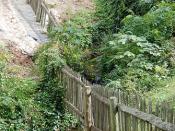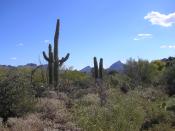Prehistory: Hohokam
The Hohokam, the desert farmers of the American Southwest, were centered in the middle Gila and Salt river drainage basins in the semiarid Sonoran Desert of Arizona. This landscape had some mountain ranges separated by level basins or plains. The mountains were important as a source of natural water in springs and rock tanks and as a collector of rain as runoff for floodwater farming. High temperatures, low humidity, and little rain characterize the desert climate.
Hohokam villages lack the romance and dramatic visual appeal of cliff swellings and large pueblos, and the heat of the desert discourages summer work. Some hypotheses of Hohokam origins also recognize a migration from Mexico.
Early Pioneer period settlements were small, but they had a large enough population to construct long, wide canals and to produce quantities of luxury goods. The square structures of the oldest houses were unusually large. The square structures have four-post quadrilateral roof support system.
The earliest ceramic products were simple, although technically well constructed. The designs are simple geometric forms, usually made with wide lines. The famous stone and shell industries of the Hohokam also had their genesis early in the pioneer period. The Hohokam are justly famous for their profuse work in shell.
The Colonial period was one of expansion for the Hohokam. Their range was extended into drainage's tributary to the Salt and Gila rivers. The reasons for expansion were probably manifold. Colonial period sites have been the object of more excavation than those of any other period. During the Colonial period work in stone becomes much more elaborate, although there is little change in the fashioning of utilitarian stone tools.
Classic Hohokam was a period of great change with evidence of social interaction from several sources. The Classic period is divided into an...


